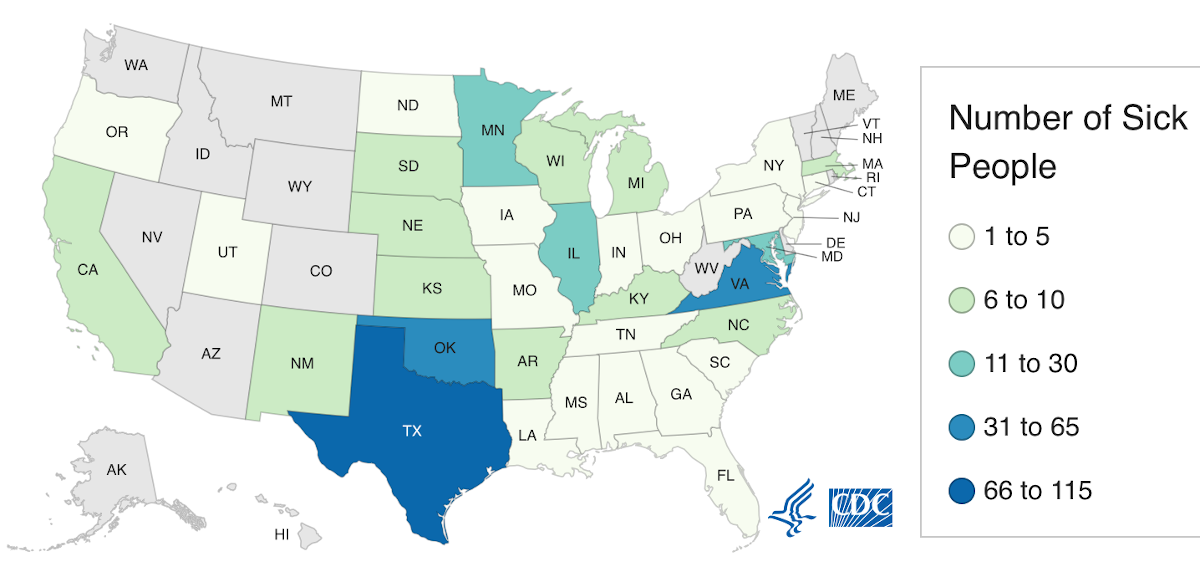The CDC has identified 140 more patients in a Salmonella Oranienburg outbreak and is still looking for the source of the infections.
With six more states added to the outbreak, the total involved now stands at 35. The new patients bring the total of confirmed patients to 419. Of those with the information available, 66 have been so sick they had to be admitted to hospitals. No deaths have been confirmed as of the update today from the Centers for Disease Control and Prevention.
The sick people by state and number of illnesses are: Alabama 1, Arkansas 8, California 6, Connecticut 4, Florida 5, Georgia 2, Illinois 28, Indiana 1, Iowa 1, Kansas 9, Kentucky 9, Louisiana 4, Maryland 22, Massachusetts 10, Michigan 6, Minnesota 20, Mississippi 2, Missouri 5, Nebraska 6, New Jersey 5, New Mexico 8, New York 3, North Carolina 7, North Dakota 2, Ohio 5, Oklahoma 63, Oregon 1, Pennsylvania 4, South Carolina 2, South Dakota 7, Tennessee 2, Texas 111, Utah 2, Virginia 38 and Wisconsin 10.
Illnesses started on dates ranging from June 19 to Sept. 14, but additional patients are expected to be identified.
The CDC and the Food and Drug Administration have been investigating the outbreak since Sept. 2 when the CDC was made aware of 20 illnesses. The FDA announced this week that traceback efforts had begun, but did not reveal what food or foods were being tracked.
“State and local officials have collected food items from some of the restaurants where sick people ate,” according to a CDC update posted on Sept. 24.
“The outbreak strain of Salmonella Oranienburg was found in a sample taken from a takeout condiment cup containing cilantro and lime. The sick person reported that the condiment container also contained onions, but none were left in the cup when it was tested.
“Because multiple food items were present in the container and in the sample that was tested, it is not possible to know which food item was contaminated. We are using this information in conjunction with other available information to help narrow the list of possible foods linked to illness.”
As of today, the CDC was reporting that sick people range in age from less than 1 year to 91 years old, with a median age of 37. Fifty-six percent of the patients are female. Of 214 people with information available, one-third have been hospitalized.
The true number of sick people in an outbreak is likely much higher than the number reported, and the outbreak may not be limited to the states with known illnesses, according to the CDC. This is because many people recover without medical care and are not tested for Salmonella infection. In addition, recent illnesses may not yet be reported as it usually takes 3 to 4 weeks to determine if a sick person is part of an outbreak.
Through interviews with infected people, public health workers have found several “subclusters” of people who ate at restaurants in multiple states before becoming ill. The subclusters are groups of people who did not know each other but who ate at the same restaurants.
The CDC and FDA are closely investigating the subclusters in hopes of finding a common food source.
About Salmonella infections
Food contaminated with Salmonella bacteria does not usually look, smell, or taste spoiled. Anyone can become sick with a Salmonella infection. Infants, children, seniors, and people with weakened immune systems are at higher risk of serious illness because their immune systems are fragile, according to the CDC.
Anyone who has developed symptoms of Salmonella infection should seek medical attention. Special tests are necessary to diagnose salmonellosis. Salmonella infection symptoms can mimic other illnesses, frequently leading to misdiagnosis.
Symptoms of Salmonella infection can include diarrhea, abdominal cramps, and fever within 12 to 72 hours after eating contaminated food. Otherwise, healthy adults are usually sick for four to seven days. In some cases, however, diarrhea may be so severe that patients require hospitalization.
Older adults, children, pregnant women, and people with weakened immune systems, such as cancer patients, are more likely to develop a severe illness and serious, sometimes life-threatening conditions.
Some people get infected without getting sick or showing any symptoms. However, they may still spread the infections to others.
(To sign up for a free subscription to Food Safety News, click here.)
